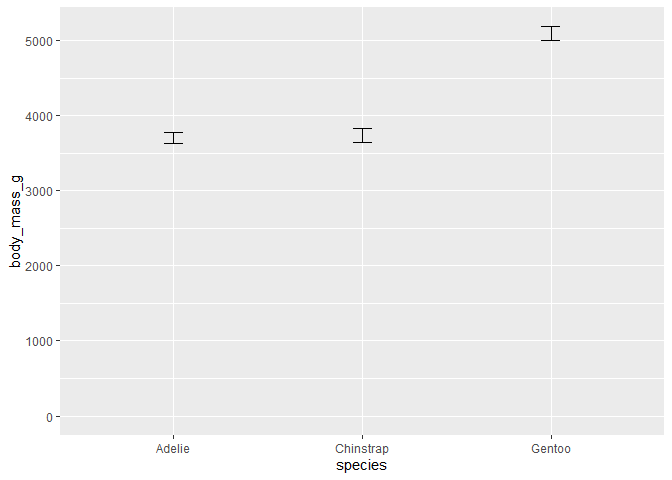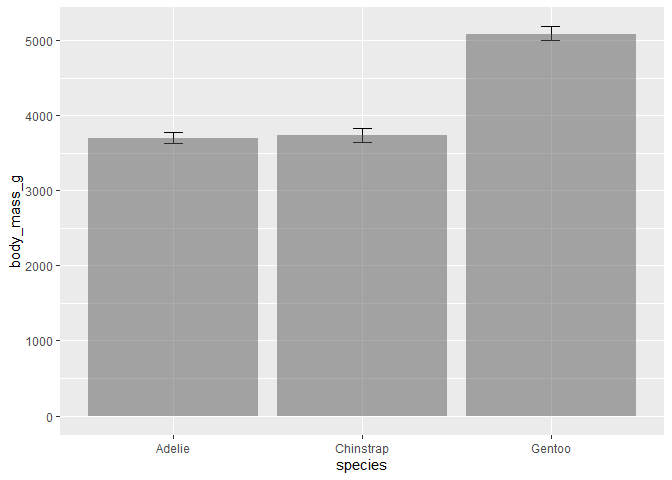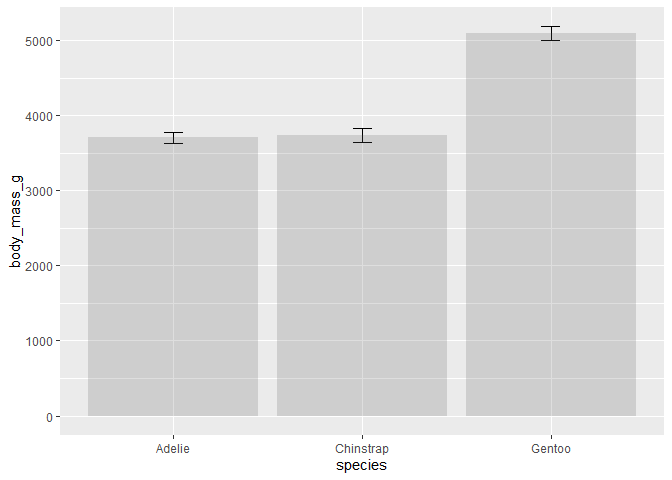library(tidyverse)
library(palmerpenguins)
p <- penguins %>%
tidyr::drop_na() %>%
ggplot(aes(x = species, y = body_mass_g)) +
geom_errorbar(stat = "summary",
fun.data = \(x) mean_se(x, 1.96),
width = 0.1) +
expand_limits(y = 0)
p

p +
geom_bar(stat = "summary", fun.data = \(x) mean(x))
#> Error in `geom_bar()`:
#> ! Problem while setting up geom.
#> ℹ Error occurred in the 3rd layer.
#> Caused by error in `compute_geom_1()`:
#> ! `geom_bar()` requires the following missing aesthetics: y
#> Backtrace:
#> ▆
#> 1. ├─base::tryCatch(...)
#> 2. │ └─base (local) tryCatchList(expr, classes, parentenv, handlers)
#> 3. │ ├─base (local) tryCatchOne(...)
#> 4. │ │ └─base (local) doTryCatch(return(expr), name, parentenv, handler)
#> 5. │ └─base (local) tryCatchList(expr, names[-nh], parentenv, handlers[-nh])
#> 6. │ └─base (local) tryCatchOne(expr, names, parentenv, handlers[[1L]])
#> 7. │ └─base (local) doTryCatch(return(expr), name, parentenv, handler)
#> 8. ├─base::withCallingHandlers(...)
#> 9. ├─base::saveRDS(...)
#> 10. ├─base::do.call(...)
#> 11. ├─base (local) `<fn>`(...)
#> 12. └─global `<fn>`(input = base::quote("peppy-flea_reprex.R"))
#> 13. └─rmarkdown::render(input, quiet = TRUE, envir = globalenv(), encoding = "UTF-8")
#> 14. └─knitr::knit(knit_input, knit_output, envir = envir, quiet = quiet)
#> 15. └─knitr:::process_file(text, output)
#> 16. ├─base::withCallingHandlers(...)
#> 17. ├─knitr:::process_group(group)
#> 18. └─knitr:::process_group.block(group)
#> 19. └─knitr:::call_block(x)
#> 20. └─knitr:::block_exec(params)
#> 21. └─knitr:::eng_r(options)
#> 22. ├─knitr:::in_input_dir(...)
#> 23. │ └─knitr:::in_dir(input_dir(), expr)
#> 24. └─knitr (local) evaluate(...)
#> 25. └─evaluate::evaluate(...)
#> 26. └─evaluate:::evaluate_call(...)
#> 27. ├─evaluate (local) handle(...)
#> 28. │ └─base::try(f, silent = TRUE)
#> 29. │ └─base::tryCatch(...)
#> 30. │ └─base (local) tryCatchList(expr, classes, parentenv, handlers)
#> 31. │ └─base (local) tryCatchOne(expr, names, parentenv, handlers[[1L]])
#> 32. │ └─base (local) doTryCatch(return(expr), name, parentenv, handler)
#> 33. ├─base::withCallingHandlers(...)
#> 34. ├─base::withVisible(value_fun(ev$value, ev$visible))
#> 35. └─knitr (local) value_fun(ev$value, ev$visible)
#> 36. └─knitr (local) fun(x, options = options)
#> 37. ├─base::withVisible(knit_print(x, ...))
#> 38. ├─knitr::knit_print(x, ...)
#> 39. └─knitr:::knit_print.default(x, ...)
#> 40. └─evaluate (local) normal_print(x)
#> 41. ├─base::print(x)
#> 42. └─ggplot2:::print.ggplot(x)
#> 43. ├─ggplot2::ggplot_build(x)
#> 44. └─ggplot2:::ggplot_build.ggplot(x)
#> 45. └─ggplot2:::by_layer(...)
#> 46. ├─rlang::try_fetch(...)
#> 47. │ ├─base::tryCatch(...)
#> 48. │ │ └─base (local) tryCatchList(expr, classes, parentenv, handlers)
#> 49. │ │ └─base (local) tryCatchOne(expr, names, parentenv, handlers[[1L]])
#> 50. │ │ └─base (local) doTryCatch(return(expr), name, parentenv, handler)
#> 51. │ └─base::withCallingHandlers(...)
#> 52. └─ggplot2 (local) f(l = layers[[i]], d = data[[i]])
#> 53. └─l$compute_geom_1(d)
#> 54. └─ggplot2 (local) compute_geom_1(..., self = self)
#> 55. └─ggplot2:::check_required_aesthetics(...)
#> 56. └─cli::cli_abort(message, call = call)
#> 57. └─rlang::abort(...)
Created on 2023-05-25 with reprex v2.0.2

